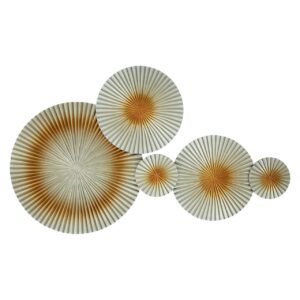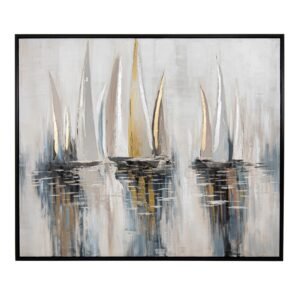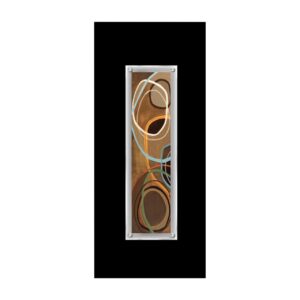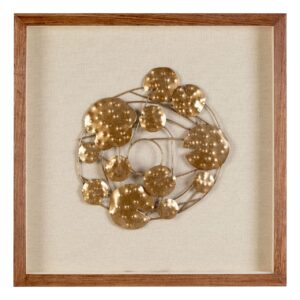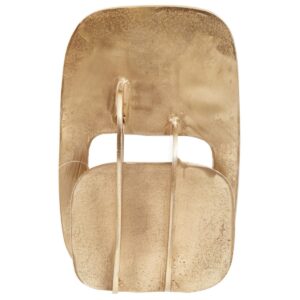Art is essential in interior design, breathing life, personality, and significance into spaces. Within interior design, art functions as a potent medium for self-expression, narrative, and crafting a distinct ambiance that mirrors the homeowner’s preferences and style. Whether it takes the form of a striking painting, a sculptural marvel, or a captivating photograph, art possesses the transformative ability to elevate ordinary rooms into extraordinary experiences, making them more welcoming, stimulating, and emotionally resonant.
Abstract art, in particular, holds a unique position in interior design due to its adaptability, innovation, and capacity to elicit diverse emotions and interpretations. Unlike representational art that depicts recognizable objects or scenes, abstract art relies on shapes, colors, lines, and forms to communicate a message or evoke a sentiment. This departure from literal representation empowers abstract art to transcend boundaries, ignite imagination, and foster a sense of enigma and fascination within interior spaces. Abstract art is a style of art that does not attempt to represent an accurate depiction of visual reality. Instead, abstract art focuses on shapes, colors, forms, and gestural marks to convey emotions, ideas, or concepts. It often emphasizes the artist’s expression and interpretation of the world rather than depicting recognizable objects or scenes.
It can take various forms, including paintings, sculptures, drawings, and mixed media. It encompasses a wide range of styles and approaches, from the geometric precision of geometric abstraction to the spontaneous and gestural marks of abstract expressionism. It invites viewers to interpret and engage with the artwork on a personal and subjective level, encouraging contemplation and exploration of the artist’s intentions and the emotional resonance of the work. It has surged in popularity, weaving its enigmatic allure into the fabric of modern living spaces. abstract art serves as more than mere decoration; its a catalyst for transformation, infusing spaces with energy, depth, and personality

Understanding Abstract Art
Abstract art is a form of artistic expression that breaks away from traditional representation of objects and scenes. Instead of depicting recognizable forms, abstract art focuses on shapes, colors, lines, and textures to convey ideas and emotions. This type of art often lacks a specific subject matter, allowing viewers to interpret and experience it in their own unique ways. Characteristics of abstract art include non-representational imagery, emphasis on visual elements, and a sense of freedom in artistic expression.
The evolution of abstract art can be traced back to the early 20th century, with pioneers like Wassily Kandinsky and Kazimir Malevich exploring new ways of expressing artistic concepts. In the late 19th and early 20th centuries, amidst a backdrop of rapid industrialization and cultural upheaval, artists began to challenge the conventions of representational art. Influenced by movements like Impressionism and Post-Impressionism, painters such as Claude Monet and Vincent van Gogh experimented with new techniques to capture light, color, and emotion in innovative ways.
As the century progressed, a wave of avant-garde movements emerged, each pushing the boundaries of artistic expression. In 1910, Wassily Kandinsky painted “Composition V,” a groundbreaking work widely regarded as one of the first purely abstract paintings. Alongside pioneers like Kazimir Malevich and Piet Mondrian, Kandinsky sought to liberate art from the constraints of literal representation, instead exploring the power of form, color, and composition to convey meaning.
Throughout the 20th century, abstract art continued to evolve, giving rise to diverse movements and styles. From the geometric precision of Constructivism to the spontaneous energy of Abstract Expressionism, artists explored a multitude of approaches to abstraction, each reflecting the cultural, social, and political landscapes of their time.
As abstract art gained prominence within the art world, its influence began to extend beyond gallery walls and into interior spaces. In the mid-20th century, designers such as Le Corbusier and Mies van der Rohe embraced abstract art as a complement to modernist architecture, integrating bold, geometric compositions into their interior schemes.
In recent decades, abstract art has experienced a resurgence in popularity within interior design, fueled by a desire for individuality, expression, and visual intrigue. From minimalist abstractions to vibrant, expressive works, abstract art offers designers and homeowners a versatile tool for transforming spaces and creating unique atmospheres.
Today, abstract art plays a vital role in interior design, serving as a focal point, conversation starter, and reflection of personal style. Whether adorning the walls of residential homes, corporate offices, or hospitality venues, abstract art infuses spaces with energy, emotion, and a sense of artistic sophistication.
The journey of abstract art from avant-garde experimentation to mainstream acceptance within interior design reflects its enduring appeal and timeless relevance. As we continue to navigate the complexities of the modern world, abstract art stands as a testament to the power of creativity, imagination, and the boundless possibilities of artistic expression.
Forms of Abstract Art
Abstract art can be created using a variety of media, each offering its own unique characteristics and possibilities for artistic expression. Different materials and techniques provided by the various media offer unique possibilities for artists to explore texture, color, shape, and form, allowing them to convey their artistic vision in diverse ways. While the various media in which abstract art can be represented certainly contribute to its expression, the expression of abstract art goes beyond just the materials and techniques used. Abstract art is primarily about conveying emotions, ideas, and concepts through non-representational forms, regardless of the medium employed. The following are some of the media in which abstract art can be represented and some popular examples:
- Painting: Abstract painting is perhaps the most well-known and widely practiced form of abstract art. Oil, acrylic, watercolor, and mixed media painting techniques offer artists a wide range of options for creating expressive and dynamic abstract compositions. Artists can play with layering, blending, and mark-making to convey emotions and evoke mood within their artworks.
- Drawing: Abstract drawings can be created using a variety of tools, including pencils, charcoal, ink, and pastels. Artists may use gestural marks, geometric shapes, or organic forms to create abstract compositions on paper or other surfaces.
- Sculpture: Abstract sculpture involves creating three-dimensional artworks using a variety of materials, such as metal, wood, stone, or clay. Sculptural forms can convey a sense of volume, space, and physical presence, engaging viewers in a sensory experience.
- Printmaking: Printmaking techniques, such as etching, lithography, and screen printing, can be used to create abstract artworks with intricate patterns, textures, and colors. The process of printmaking adds a layer of complexity and depth to abstract compositions, enhancing their visual impact.
- Mixed Media: Mixed media abstract art involves combining different materials and techniques to create layered and textured artworks. Artists may incorporate elements such as collage, found objects, and experimental techniques to create unique and dynamic compositions.
Some popular examples of abstract art in various media include:
Painting: “Composition VIII” by Wassily Kandinsky, “No. 5, 1948” by Jackson Pollock.
Drawing: “Untitled” by Cy Twombly, “Woman I” by Willem de Kooning.
Sculpture: “Bird in Space” by Constantin Brancusi, “Large Two Forms” by Henry Moore.
Printmaking: “Homage to the Square” series by Josef Albers, “The Weeping Woman” series by Pablo Picasso.
Mixed Media: “Just What Is It that Makes Today’s Homes So Different, So Appealing?” by Richard Hamilton, “Untitled (Your Gaze Hits the Side of My Face)” by Barbara Kruger.
These examples represent a diverse range of styles, techniques, and approaches to abstract art, showcasing the versatility and creativity of artists working in this genre.
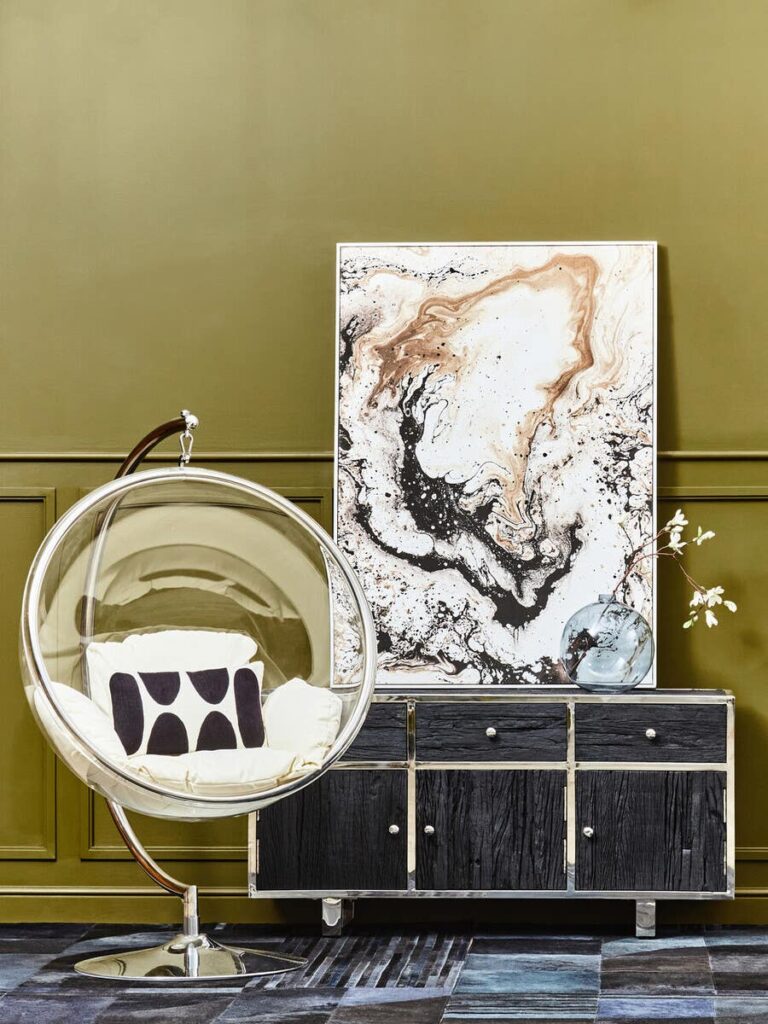
Abstract Art Styles and Their Interpretation
Abstract art encompasses a variety of styles, each with its own unique characteristics and interpretations. Understanding these styles can enrich our appreciation of abstract art in interior design.
A. Geometric Abstraction
- Geometric abstraction focuses on precise geometric shapes like squares, circles, and triangles. These shapes are often arranged in a structured and orderly manner, creating a sense of harmony and balance. Geometric abstraction can evoke feelings of orderliness, precision, and mathematical beauty.
B. Expressionist Abstract Art
- Expressionist abstract art is characterized by bold, expressive brushwork and vivid colors. It aims to convey emotions and inner experiences rather than realistic representations. Expressionist abstract art can evoke strong emotions, energy, and dynamism, making it a powerful addition to interior spaces.
C. Color Field Painting
- Color field painting emphasizes large areas of flat color, often with minimalistic compositions. The focus is on the interaction of colors and their emotional impact. Color field painting can create a sense of calmness, tranquility, and contemplation in interior settings.
D. Surrealist Abstract Art
- Surrealist abstract art explores the realm of dreams, fantasies, and the subconscious mind. It often features surreal imagery, unexpected juxtapositions, and symbolic motifs. Surrealist abstract art can spark imagination, curiosity, and introspection in viewers, adding an element of mystery and intrigue to interiors.
E. Minimalist Abstract Art
- Minimalist abstract art simplifies forms to their essential elements, using clean lines, geometric shapes, and limited color palettes. The focus is on simplicity, purity, and the beauty of minimalism. Minimalist abstract art can create a sense of serenity, clarity, and visual balance in interior spaces.
F. Contemporary Abstract Art
- Contemporary abstract art encompasses a wide range of styles and approaches, reflecting the diversity and experimentation in modern art. It can include mixed media, digital art, conceptual art, and more. Contemporary abstract art is dynamic, innovative, and ever-evolving, offering endless possibilities for creative expression in interior design.
Exploring these abstract art styles and their interpretations can help homeowners, designers, and art enthusiasts choose art pieces that resonate with their aesthetic preferences, emotions, and design goals for interior spaces. Each style brings its own unique charm, symbolism, and visual impact, adding depth, personality, and artistic flair to home environments.
Characteristics of Interior Abstract Art
Interior abstract art encompasses a variety of features that distinguish it within the realm of interior design. Some key features include:
1. Non-representational Forms: Interior abstract art typically is characterized by its departure from literal representation(that is, depicting recognizable subjects), instead focusing on the formal elements of art —such as form, color, line, and texture. This allows for a greater degree of subjective interpretation and emotional resonance.
2. Expressive Use of Color: Abstract art often employs bold and vibrant colors to evoke mood, atmosphere, and emotion within a space. Colors may be used in dynamic or unexpected ways to create visual interest and focal points.
3. Dynamic Compositions: Interior abstract art frequently features dynamic compositions characterized by movement, balance, and rhythm. Artists may employ techniques such as layering, juxtaposition, and gestural marks to create visually engaging and dynamic artworks.
4. Textural Elements: Texture plays a significant role in many interior abstract artworks, adding depth, tactility, and visual intrigue. Artists may use a variety of materials and techniques, such as impasto, collage, or mixed media, to create textural richness and complexity.
5. Scale and Proportion: The scale and proportion of interior abstract art can greatly impact its presence within a space. Large-scale artworks can serve as striking focal points, while smaller pieces may offer subtler accents or points of interest within a room.
6. Versatility and Adaptability: Interior abstract art is known for its versatility and adaptability to a wide range of design styles and aesthetics. Whether adorning modern, minimalist interiors or eclectic, bohemian spaces, abstract art can seamlessly integrate and enhance a variety of design schemes.
7. Personal Interpretation: One of the defining features of abstract art is its openness to personal interpretation. Interior abstract artworks invite viewers to engage with the artwork on a subjective level, encouraging contemplation, introspection, and emotional connection.
8. Customization and Commissioning: Interior abstract art offers the opportunity for customization and commissioning, allowing homeowners, designers, and collectors to collaborate with artists to create bespoke artworks tailored to specific spaces, preferences, and requirements
Benefits of Abstract Art in Interior Design
Picture this: You step into a room, and your eyes are immediately drawn to a captivating artwork adorning the wall. Bold colors dance across the canvas, intricate patterns weave together in a mesmerizing display, and you find yourself lost in the depths of the abstract composition.
This is the impact of abstract art in interior design—a transformative experience that transcends mere decoration and becomes a central element of the space. As you gaze upon the artwork, you feel a wave of emotions wash over you, each brushstroke and color choice conveying a different mood or message. This impact is multifaceted and discussed in detail below:
- Emotional Impact: Abstract art has the power to evoke emotions and moods within a space. The colors, shapes, and compositions of abstract artworks can create feelings of joy, serenity, excitement, or contemplation, depending on the individual piece and its placement within the room. By eliciting emotional responses, abstract art can enhance the overall ambiance and atmosphere of an interior space.
- Visual Interest and Focal Points: Abstract art serves as a focal point within a room, drawing the eye and capturing attention. Whether displayed prominently on a feature wall or strategically placed within a gallery arrangement, abstract artworks add visual interest and depth to interior spaces. They create dynamic focal points that anchor the room and invite exploration and engagement from viewers.
- Expression of Personal Style: Abstract art allows homeowners and designers to express their personal style and aesthetic preferences within a space. By selecting artworks that resonate with their tastes and sensibilities, individuals can infuse their interiors with a sense of individuality, creativity, and personality. Abstract art serves as a form of self-expression, reflecting the unique perspectives and identities of those who inhabit the space.
- Versatility and Adaptability: Abstract art is incredibly versatile and adaptable to a wide range of design styles and aesthetics. Whether adorning modern, minimalist interiors or eclectic, bohemian spaces, abstract art seamlessly integrates and enhances diverse design schemes. Its versatility lies in its ability to transcend stylistic boundaries and complement a variety of architectural elements, furnishings, and décor.
- Enhancement of Spatial Dynamics: Abstract art can enhance the spatial dynamics of a room, creating visual depth, movement, and balance. The interplay of shapes, colors, and textures in abstract artworks can visually expand or contract a space, depending on the desired effect. Through careful placement and arrangement, abstract art can manipulate perceptions of scale, proportion, and perspective within interior environments.
- Conversation Starter and Statement Piece: Abstract art serves as a conversation starter and statement piece within interior spaces. Whether displayed in a residential home, corporate office, or hospitality venue, abstract artworks spark dialogue, intrigue, and curiosity among viewers. They serve as catalysts for meaningful interactions and reflections, fostering connections and engagement within the space.
- Cultural and Symbolic Significance: Abstract art often carries cultural and symbolic significance, reflecting broader societal, historical, and philosophical themes. By incorporating abstract artworks with cultural or symbolic resonance into interior design, individuals can imbue their spaces with deeper meaning and significance. Abstract art becomes more than just decorative adornment; it becomes a reflection of cultural identity, values, and aspirations.
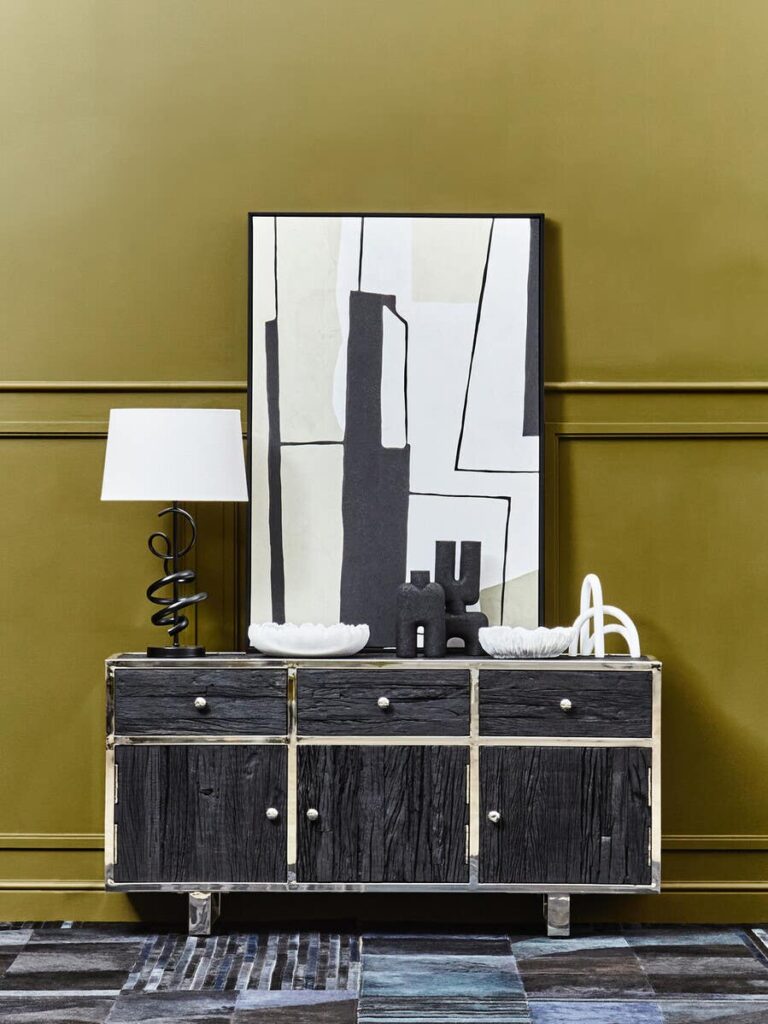
Tips for Integrating Abstract Art in Your Home.
Abstract art is a powerful tool in interior design, adding depth, personality, and visual interest to living spaces. When incorporating abstract art into interior design, several key considerations come into play to ensure a cohesive and harmonious look. This includes choosing the right art pieces for different spaces, strategically placing them for maximum impact, and harmonizing them with existing decor and color schemes.
A. Choosing the Right Art Pieces for Different Spaces
When selecting abstract art for interior spaces, it’s important to consider the style, size, and theme of the artwork in relation to the room’s overall design concept. For example, a large, bold abstract painting might be suitable for a spacious living room or dining area, creating a focal point and adding drama to the space. On the other hand, smaller abstract pieces or art prints can be ideal for intimate areas like bedrooms or home offices, adding a touch of creativity without overwhelming the space.
B. Placement Considerations for Maximum Impact
The placement of abstract art can significantly impact its visual impact and the overall ambiance of a room. Consider placing artwork at eye level, such as on walls facing seating areas or above furniture, to ensure it is easily visible and becomes a focal point. Experimenting with placement, such as creating gallery walls or arranging multiple pieces in a cohesive layout, can also add dynamism and interest to a space.
C. Harmonizing Abstract Art with Existing Decor and Color Schemes
Abstract art should complement rather than clash with existing decor and color schemes in a room. Consider the color palette of the artwork and how it interacts with the colors of walls, furniture, and accessories. Harmonizing colors can create a sense of unity and flow in the space while contrasting colors can add drama and visual interest. Additionally, consider the style and theme of the abstract art about the overall design style of the room, ensuring a cohesive and balanced look.
Other Considerations
Selecting the Right Piece.
Selecting the abstract art for your interior space is an important step towards incorporating abstract art in your space. It is a personal and subjective process, but there are several key factors to consider to ensure that the artwork enhances your space and resonates with your style and aesthetic preferences. Here are some things to look out for when selecting abstract art:
- Color Palette: The color palette of the artwork should complement the existing colors in your space. Consider the dominant colors in your décor and look for artwork that incorporates similar or complementary hues. Pay attention to the mood and atmosphere you want to create, as different colors can evoke different emotions.
Style and Composition: Consider the style and composition of the artwork in relation to your interior design. Abstract art comes in many styles, from geometric and minimalist to expressive and gestural. Choose a style that complements the overall aesthetic of your space and creates visual harmony. - Size and Scale: The size of the artwork should be proportionate to the wall or space where it will be displayed. A large, bold piece can make a statement and serve as a focal point, while smaller pieces can be grouped together to create a gallery wall effect. Consider the scale of your furniture and other elements in the room when selecting the size of the artwork.
- Texture and Material: Texture can add depth and interest to abstract art. Consider the texture and material of the artwork, as well as how it will interact with other textures in your space. For example, a textured painting can add warmth and dimension to a room, while a glossy finish can create a modern and sleek look.
- Subjective Interpretation: Abstract art is open to subjective interpretation, so choose artwork that speaks to you personally. Consider the emotions, ideas, or messages that the artwork conveys and how it resonates with your own experiences and perspectives.
- Budget and Investment: Consider your budget when selecting abstract art. While original artworks can be a significant investment, there are also affordable options available, such as prints and reproductions. Choose artwork that fits within your budget and that you will enjoy for years to come.
- Placement and Lighting: Think about where and how the artwork will be displayed in your space. Consider the natural and artificial lighting in the room, as well as the viewing angle and sight lines. Ensure that the artwork is placed in a location where it can be appreciated and admired.
- Artistic Value and Authenticity: Finally, consider the artistic value and authenticity of the artwork. Research the artist and their work to ensure that you are purchasing a genuine piece of art. Consider the artistic merit and significance of the artwork, as well as its potential to appreciate in value over time.
Creative Placement and Display
Including abstract art in your interior design is not just about finding the perfect piece—it’s about embracing creativity, experimentation, and imagination in the way you display and interact with the artwork. With this creative placement and display ideas, you can showcase your abstract art in style and transform your space into a gallery-worthy masterpiece. Match different pieces to create visual interest and dynamism, experimenting with various compositions until you find the perfect arrangement.
- Gallery Wall Extravaganza: Transform a blank wall into a gallery-style showcase by arranging a collection of abstract artworks in a diverse array of sizes, shapes, and frames. Mix and match pieces to create a dynamic display that captures attention and sparks conversation. Consider placing a single, large-scale abstract artwork above a focal point in the room, such as a fireplace, sofa, or bed, allowing it to command attention and serve as the focal point of the space, adding drama and sophistication.
- Unexpected Nooks and Crannies: Think outside the box and explore unconventional placement options for your abstract art, such as alcoves, corners, or even ceilings. Surprise and delight guests by displaying artwork in unexpected locations, creating moments of visual intrigue and surprise throughout the space.
- Dynamic Duo: Create visual harmony and balance by pairing two complementary abstract artworks together, either side by side or in a stacked arrangement. You could also pair abstract art with other decorative elements, such as sculptures, plants, or textiles, to create dynamic vignettes. Play with contrasting colors, textures, and compositions to create a dynamic visual dialogue between the pieces, enhancing the overall impact and appeal.
- Symmetrical Serenity: Achieve a sense of symmetry and balance by hanging identical or mirrored abstract artworks on either side of a central axis, such as a doorway or window. This creates a sense of harmony and cohesion within the space, while also adding a touch of elegance and sophistication to the room.
- Artistic Alcoves: Transform unused alcoves or recessed areas into artistic showcases by installing built-in shelving or display niches to house your abstract art collection. Highlight individual pieces or curated groupings of artwork within these dedicated alcoves, creating intimate and immersive viewing experiences for guests.
- Layered Look: Experiment with layering multiple pieces of abstract art to create depth and dimension within the space. Overlay smaller artworks on top of larger ones or lean framed pieces against the wall to create a layered effect, adding visual interest and complexity to the arrangement.
From creating focal points that anchor a room to sparking meaningful conversations and reflections, abstract art invites us on a journey of exploration, interpretation, and self-expression. It serves as a reflection of our individuality, our tastes, and our aspirations, infusing our spaces with creativity, imagination, and a sense of personal identity. It reminds us of the boundless possibilities of artistic expression and the power of beauty to uplift, inspire, and transform our lives.


